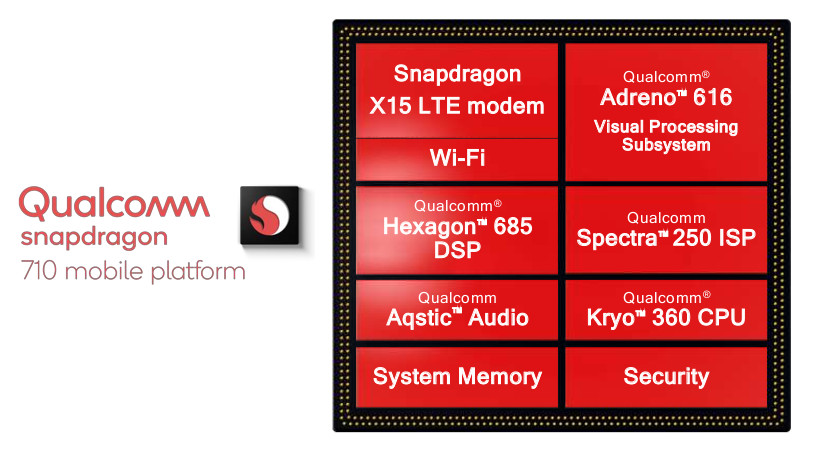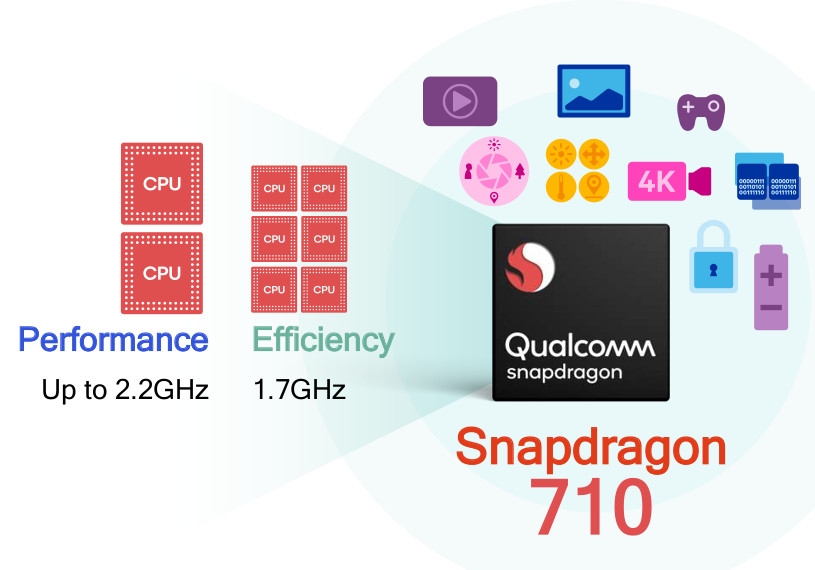
Qualcomm just introduced Snapdragon 710 Mobile Platform, the company’s first SoC in the new 700 series. It is built on power-efficient 10nm process technology based on new Kryo 360 architecture, built on ARM Cortex technology. This promises 2X overall performance improvements in AI applications, up to a 20% overall uplift in performance, 25% faster web browsing and 15% faster app launch times, compared to the Snapdragon 660, thanks to new dual performance + hexa efficient custom Kryo cores.

It comes with new 14-bit Qualcomm Spectra 250 ISP for improved low light photography, noise reduction, fast autofocus, image stabilization, smooth zoom, real-time bokeh effects and Face ID / Unlock with active depth sensing. It also supports 4K HDR playback for viewing HDR videos and apps, for the first time outside the premium 800-tier.
The new Adreno 616 GPU promises 40% reduction in power consumption for both gaming and 4K HDR video playback, as well as a 20% reduction in power consumption when streaming video, when compared to Snapdragon 660.
Qualcomm Snapdragon 710 Mobile Platform specifications
- Octa-Core – Dual 2.2GHz Kryo 360 (performance) + Hexa 1.7GHz Kryo 360 (efficiency) CPUs
- 10nm process technology
- Up to 16GB memory, 2×16 LPDDR4x 1866MHz, eMMC, UFS 2.1 hear 3 1-lane, SD 3.0, USB 3.1 Gen 1 Type-C & USB 2.0
- Qualcomm Adreno 616 GPU
- Qualcomm Spectra 250 ISP – Up to 32 MP single camera, 20MP dual camera, Zero Shutter Lag, Hybrid Autofocus, Ultra HD 4K video capture at 30fps, High quality video capture with Motion Compensated Temporal Filtering, Accelerated Electronic Image Stabilization
- Supports up to QHD+ (2560×1600) displays
- Qualcomm Hexagon 685 DSP, Qualcomm All-Ways Aware technology
- Up to 4K Ultra HD Premium playback, Up to 4K UltraHD capture @ 30 FPS, Up to 1080p video capture @120 FPS, H.264 (AVC), H.265 (HEVC), VP9, VP8
- Dual-band 802.11ac with MU-MIMO 2×2, GPS, Glonass, BeiDou, Galileo, QZSS, and SBAS and Bluetooth 5
- Qualcomm Quick Charge 4+ technology
The Snapdragon 710 Mobile Platform is available for OEMs and it expected in mobile devices in second quarter of 2018.
